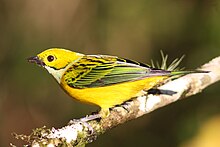Silver-throated tanager
| Silver-throated tanager | |
|---|---|

| |
| Scientific classification | |
| Domain: | Eukaryota |
| Kingdom: | Animalia |
| Phylum: | Chordata |
| Class: | Aves |
| Order: | Passeriformes |
| Family: | Thraupidae |
| Genus: | Tangara |
| Species: | T. icterocephala
|
| Binomial name | |
| Tangara icterocephala (Bonaparte, 1851)
| |

| |
The silver-throated tanager (Tangara icterocephala) is a small passerine bird. This brightly coloured tanager is a resident from Costa Rica, through Panama and western Colombia, to western Ecuador.
Description
The adult silver-throated tanager is 13 centimetres (5.1 in) long and weighs 21 grams (0.74 oz). The male is mainly yellow, with black streaks down its back, and a whitish throat bordered above with a black malar stripe. The wings and tail are black with pale green edgings. The sexes are similar, but adult females have duller and greener-tinged yellow plumage, and sometimes dark mottling on the crown. Immatures are much duller and greener, with dusky wings, tail, back streaks and malar stripe, a grey throat and darker green wing edging. The silver-throated tanager's call is a distinctive sharp buzzy zzeeep. It does not sing.
Distribution and habitat
In Costa Rica it is a common bird from 600 to 1,700 metres (2,000 to 5,600 ft) altitude in the lower and middle levels of wet mountain forests and adjacent semi-open areas like clearings with shade trees, second growth and woodland edges. In the heavy rains of the wet season, it will descend to sea level. In the South American part of its range it mainly occurs between 500 and 1,300 metres (1,600 and 4,300 ft), but can be found at altitudes of 150 to 2,100 metres (490 to 6,890 ft).
Behavior
Silver-throated tanagers occur in pairs, small groups, or as part of a mixed-species feeding flock. They eat small fruit, usually swallowed whole, insects and spiders.
The compact cup nest is built 1–13 metres (3.3–42.7 ft) in a tree on a branch. The normal clutch is two brown-blotched off-white eggs. This species will raise two broods in a season.
References
- ^ BirdLife International (2012). "Tangara icterocephala". IUCN Red List of Threatened Species. 2012. Retrieved 26 November 2013.
{{cite journal}}: Invalid|ref=harv(help)
Further reading
- Skutch, Alexander F. (1954). "Silver-throated tanager" (PDF). Life Histories of Central American Birds. Pacific Coast Avifauna, Number 31. Berkeley, California: Cooper Ornithological Society. pp. 226–234.
External links
- Silver-throated Tanager videos on the Internet Bird Collection
- Silver-throated Tanager photo gallery VIREO (includes picture of egg clutch)
- Photo-High Res--(Close-up of front and throat); Article nationalzoo.si.edu–"Smithsonian: Bird Photo Gallery"
- Photo-High Res--(Close up); Article & photo gallery mangoverde

